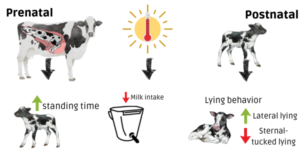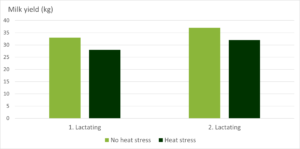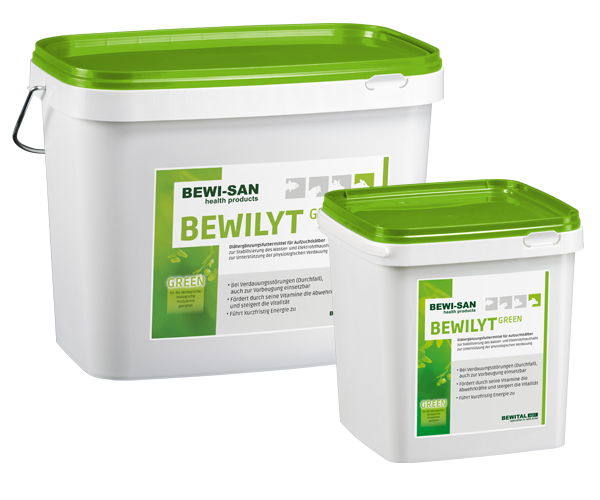Also calves suffer from heat stress
During heat stress conditions, most farmers think about their dairy cows first, but the effects on calves are no less serious. The stress can begin in the womb. Lower birth weights, a weakened immune system and reduced feed intake lead to a poor start in life. This also has consequences for the milk yield later on.
Therefore, it is necessary to improve conditions here as well so that long-term reductions in performance are avoided.
Current studies:
Recent research by DADO- SENN et al. 2022 in Florida confirmed that heat stress of the cow before calving has an impact on the behaviour of calves after birth. Besides reduced feed intake and weakened immune system, heat stress also affects thermoregulatory behaviours.
Prenatally stressed calves showed a higher rectal body temperature. Thus, high temperature stress is higher for these calves than for calves that were not prenatally stressed. This led to these calves standing more often. When standing, more heat can be released due to increased body surface area.
Postnatal heat stress led to altered lying behaviour. The calves were found to lie more often on their sides than on their chests.

Calves from heat-stressed cows show decreased growth
Trials indicate that calves out of dry cows that were not suffering from heat stress, show higher birth weights. Although this difference is relatively small compared to calves born with a favourable birth weight, there is a long term advantage: calves with an ideal birth weight show an increased growth performance, due to increased water- and feed intake and a more efficient exploitation.
This also positively influences later milk performance. Unborn calves not suffering from heat stress of the mother cows showed up to 5 kg more milk as later heifers, compared to those out of heat stresses mother cows. This can partly be explained by the fact that higher birth weights positively influence later milk performance of the animals.

Measures to reduce heat stress:
- Place igloos in the shade
- Put enough space between the igloos
- Do not overcrowd
- Replace straw with sand or shavings
- Avoid stressors (dehorning, rehousing)
- Adjust feeding times: early in the morning and late in the evening
- Choose easily digestible carbohydrates (e.g. calf flakes). They produce less body heat.
- Increase the amount or concentration of feed to meet the increased energy requirements.
- In addition, give an electrolyte drink (e.g. BEWI-SAN Bewilyt) to compensate for the loss of water and electrolytes from sweating.
Our solutions for calves: BEWI-SAN Bewilyt / BEWI-SAN Bewilyt GREEN
Calves suffer heat stress starting at an ambient temperature of around 20 °C – they sweat. Besides fluid, they also lose many vital electrolytes. These should be replenished as quickly as possible to ensure the healthy rearing of the calf.
In stress situations, offer 50 g BEWI-SAN Bewilyt per litre of water (temperature of approx. 30 °C) for free disposal:
- Immediately usable energy vitalises the calves quickly
- Compensates for the loss of fluids
- Supports the body’s defences through its vitamins and increases vitality
- Regulates the acid-base ratio in the blood

>> learn more

>> learn more